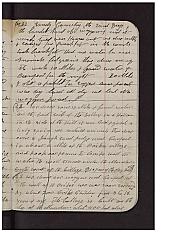
Day in the Life
Journal Entry
23
 We drove our waggon and camped at the well of
We drove our waggon and camped at the well of
the Oribas. We were soon surrounded By about 20 Oriba
children from 3 to 18 years of age all the unmarried girls
from 10 years upwards had their hair done up on the side
of the head like a pair of horns or large pair of Ears
which gives them a strange appearance this is a sign
to the young men that they are ready to marry All the
Oribas water their Animals at this well also they
carry water in large Earthern Judgs [jugs] to water the village
which stands 500 feet on the top of the Mountain above
the well. The Oribas & Moquis and all the inhabitants
of these seven villages raise large fields of corn, beans
mellons & squashes & Peach orchards down on the Earth
below them without Irrigation or water ownly what
falls from heaven which is but vary little and they raise
vary good crops. We find that sand holds mosture [moisture]
much better in a dry season than clay and soil. We went
on stone stepts & foot paths, some 500 feet to the Oribe village
containing 1000 people with quite a quantity of children
This village was compackly built of rock laid up in
mortar some four stories high all thes villages are built
On the top of the highest rocks for defence in time of war
This village was about a quarter of a mile around. The
day before our arival they had their great Dance which
kept up untill late at night and the people were rather
stupid. We went on to the top of a four story house
whare we could get a good survey of the surround[in]g
country. I found the men done the spining and a good
deal of knitting. There was about to be a marriage in
the village and all the men were gathered into the work
shops to spin cotton warp for a pair of Blankets
for the marriage couple, they spun on spindles they held
in their hands and rolled the spindle on their legs
they raised the cotton themselves and when the Blanket
is used the pair sleep under it the first night then laid
away as a sacred garm[en]t & never used again untill
the man dies then he is buried in it. The men were
in their underground work shops I could not get
them to come out to hear Preaching so I went down
into two of their work shops and spoke to them when
they were at work but found them more interested in
their work than hearing the gospel Preached I spoke to one
company of 20 to another of 30, and Ira Hatch interpeted
it I saw one white Indian called Albinos man vary
white There are some of this clan in nearly all of the
villages. They are milk white much whiter than Amer-
icans whether they are Blood of the Anicient Nephites
or a freak of Nature I cannot say they are not vary
popular among the Indians. After going through the
village and on top of the Houses most of which are
flat on top and covered with Ears of corn to dry from
pure white to jet black, the Black was generally the best
there was read yellow & blue. We then left the village
we then travelled 12 miles over vary rough ground and
camped for the night 5 M[iles]
People
Browse people Wilford Woodruff mentioned on this day in his journal. Click on the person's name to view a short bio and other pages they are mentioned on or click on "View in Family Search" to view their FamilySearch profile.
Places
Browse places mentioned in Wilford Woodruff's journal entry on this day. Click on the place names to view other pages where they are mentioned.
Quotes
View selected quotes from this page in Wilford Woodruff's journal.
we watered our animals then drove over a rough sand ridge and camped in about a mile of the Oribe village and took our team to the Oribe well to water the well stands under the Mountain South west of the village the well was 670 feet Deep and 100 feet across the top it was walled up with 4 square tarries of stones and the water 10 feet across the Bottom a steep trail leading down from top to Bottom from the last terrace there is 15 stone stepts to the Bottom when I arived at the well I found an [FIGURE] Ass or Donkey had walked down to the stone steps looking down into the water and Braying for some one to come & watering him his call was louder than any animal but an ass could make. I took my bucket and carryed him several Buckets of water which he drank greedily and when He was satisfied, He bowed his head as much as to say thank you sir and went off happy we watered our team returned to the waggon & camped 25 M[iles]
Related Documents
Browse other documents with this same date. These could include pages from Wilford Woodruff's autobiographies, daybooks, letters, histories, and personal papers. Click on the document titles to view the full document.


Daybook (28 February - 23 October 1879)

Daybook (28 February - 23 October 1879)

Daybook (28 February - 23 October 1879)

